How to clean a tea kettle: you can clean a tea kettle using common household items like vinegar and lemon. Cleaning methods vary, depending on the material of the kettle you have.
Let’s check out the best techniques for returning your kettle to its former glory!
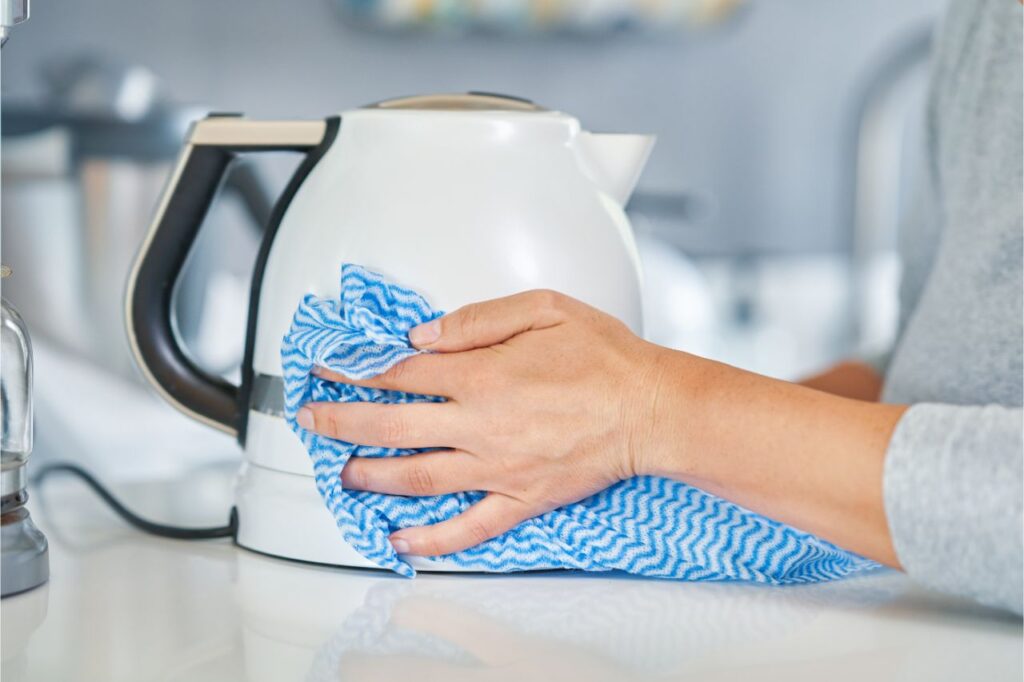
Many people wonder if we should bother cleaning our tea kettles; since water is the only thing we boil in them, right?
Wrong.
Trust me when I say you shouldn’t underestimate a clean tea kettle. And if you’re an avid tea drinker, you’ve surely seen some dirty limescale build-up on your kettle’s sides. You might also be here because you’ve realized how it’s a pain to get off.
Therefore, knowing how to clean a tea kettle the right way is extremely important.
General hygiene aside, there are plenty more reasons why you should clean your tea kettle.
The most important, in my opinion, is because It actually plays a role in how your tea tastes.
Fortunately, we’ve rounded up the ultimate guide on how to clean a tea kettle for you.
It’s fairly simple, and you only need a few materials.
Some of these you might already have on hand too.
So, let’s get started.
How To Clean A Tea Kettle: 5 Best Ways For All Kettle Types
Notice how we said, “clean a tea kettle the right way”? There are so many types of tea kettles. You might be using an electric one. On the other hand, others might be using an old cast iron kettle.
These materials require specific cleaning methods. For instance, scrubbing stainless steel might harm its grain; I’ve learned the hard way!
Most of these methods call for vinegar or lemon. If you’re wondering why it’s because of their acidic content, which makes them great natural cleaners.
When their acidity comes into contact with limescale, it will slowly dissolve it. Also, an added bonus, lemon is great for removing smells too.
Boiling water with these acids is also known as descaling.
Now, let’s get started.
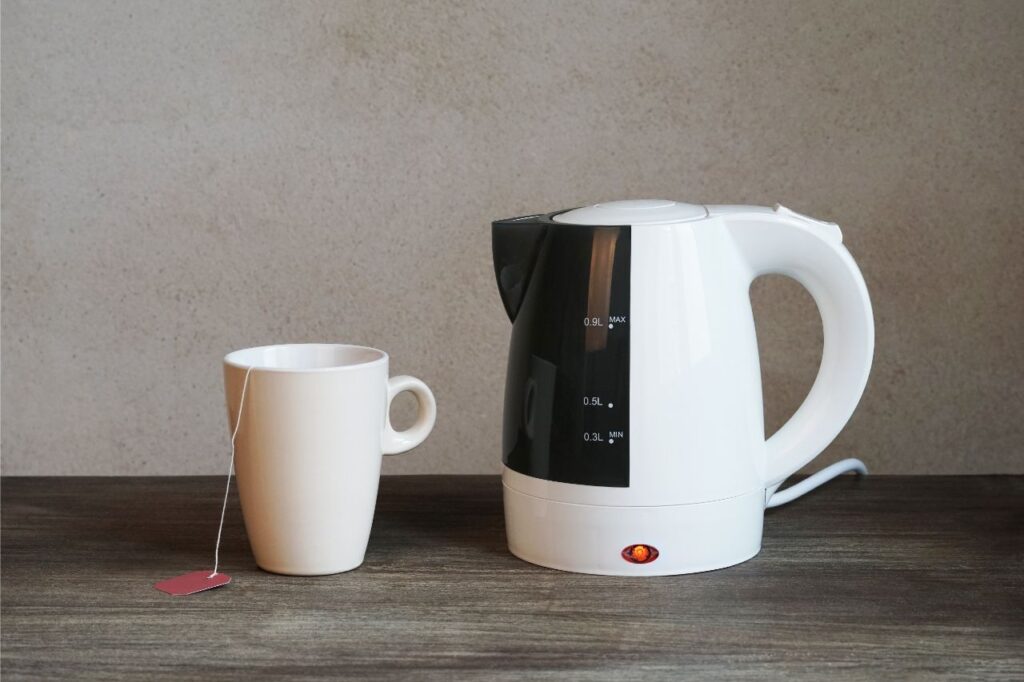
1. How To Clean An Electric Tea Kettle
You might not notice the buildup on your electric kettle. This is because all the buildup usually happens on the inside. It’s very common for the limescale to adhere to its interior.
But don’t worry; cleaning limescale from electric tea kettles is simple.
What You Need
- Liquid Soap
- Vinegar or lemon
- Water
- A soft brush (you can also use the green part of your dish sponge)
Directions For Cleaning The Interior
- Get rid of any remaining liquid inside your tea kettle.
- Then, clean the kettle using water and some liquid soap. Do a simple wash, scrub the inside, and rinse it thoroughly.
- Once it’s completely rinsed and dried, pour a 1:1 ratio of water and vinegar into your kettle.
- Place your electric kettle onto its heating apparatus and turn it on.
- Let it boil for 3-5 minutes until the limescale melts down its sides.
- Turn the heat off and let the mixture soak inside for 30 minutes.
- Afterward, proceed to rinse the electric kettle. Pour out the water and vinegar mixture (reserve the mixture for later if preferred).
- Wash with liquid soap again. This time, use your brush to scrub out any deposit or buildup.
- Rinse. Make sure to rinse thoroughly to remove the vinegar smell. Or else, this might catch onto your tea water.
- One pass of this cycle should remove all the limescale on your electric kettle. But, if it doesn’t, you can do another cycle without the vinegar.
Directions For Cleaning The Exterior
- You can reuse your vinegar water mixture from above to clean the exterior.
- Pour the mixture into the surface of the kettle.
- Then, wash and rinse with liquid soap and water.
Note: not all electric kettles are the same. Make sure to avoid any wire-to-water contact risks and ensure the kettle is unplugged from the PowerPoint when cleaning!!
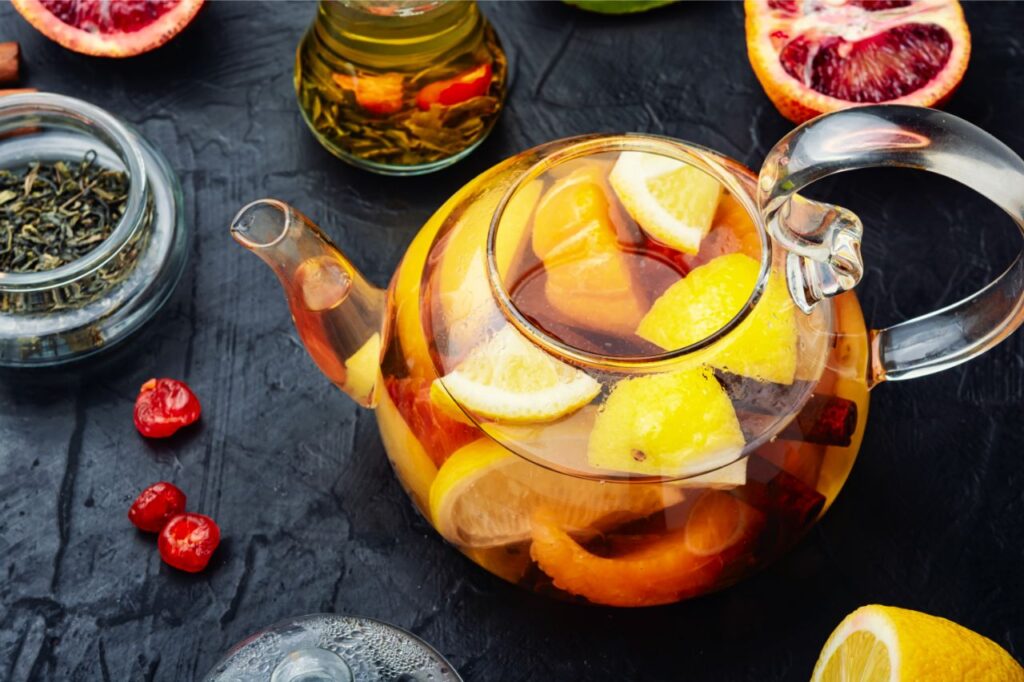
2. How To Clean A Glass Tea Kettle
Glass kettles are the easiest to clean from all the stovetop kettles. All you need is vinegar. But if your kettle has a disclaimer regarding using vinegar (some do!), you can use lemon juice.
What You Need
- Vinegar or lemon juice
- Water
- Liquid soap
Directions
- Add one part water to one part vinegar to your glass kettle.
- Let this mixture soak inside for 30 minutes up to 1 hour.
- After soaking, place it on the stove and bring it to a boil.
- Let it boil for 3-5 minutes to get rid of any limescale.
- Turn off the heat and let the mixture and kettle cool for a few minutes.
- Wash and rinse with liquid soap, and you’re done with cleaning the inside.
- To clean the exterior, simply clean it with soap and water. You can also scrub a lemon onto it to make it look good as new.
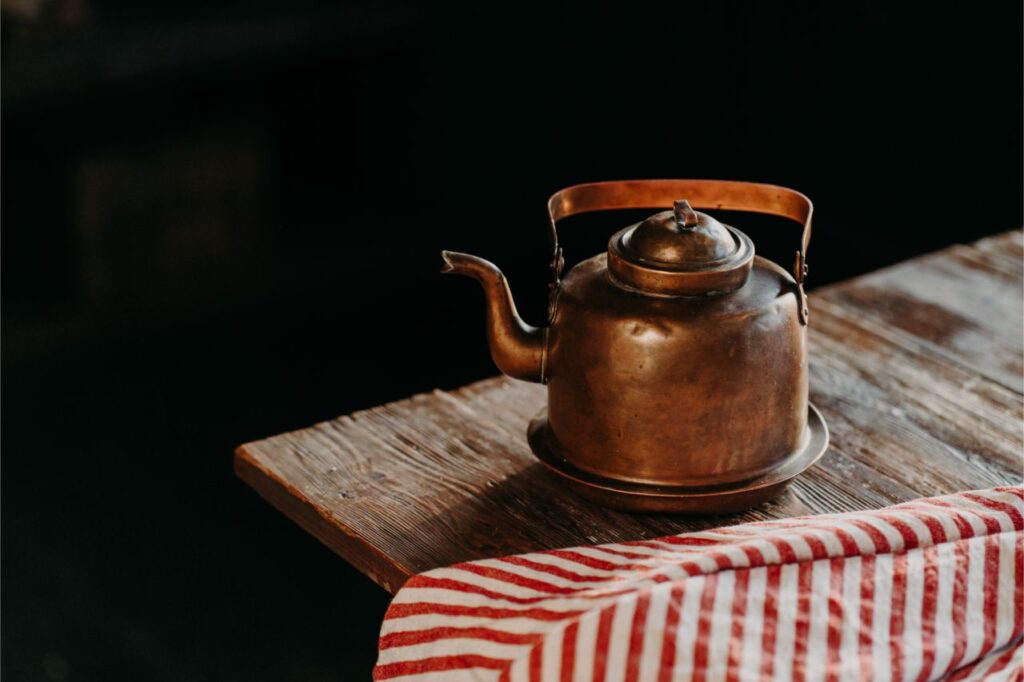
3. How To Clean A Copper Tea Kettle
Copper kettles are highly susceptible to losing shine and luster. And when it isn’t properly maintained, it can look very worn out.
I personally think this is part of the charm!
However, this is due to oxidation, it’s a naturally occurring process. But, you can make your copper tea kettle less worn out and shiner by cleaning it.
On top of this, your kettle also accumulates limescale. Therefore, regular cleaning is important.
Cleaning copper kettles has a similar cleaning method to glass kettles. Boil the vinegar-water mixture in the kettle and let it boil and soak. This should remove the limescale and buildup inside. You can refer to the steps above.
Here are the steps for cleaning its exterior:
What You Need
- Lemon
- Salt
- Liquid soap
Directions
- Mix 1 part lemon juice to 2 parts salt in a small container. This should result in a paste.
- Rub and scrub this paste onto the kettle. Don’t do it harshly. Use gentle circular motions. You can also wear rubber cloves or use a brush if you have sensitive skin.
- Do this all over the exterior until clean and shiny spots appear.
- Wipe with a kitchen towel or dry cloth.
- Wash and rinse with soap and water.
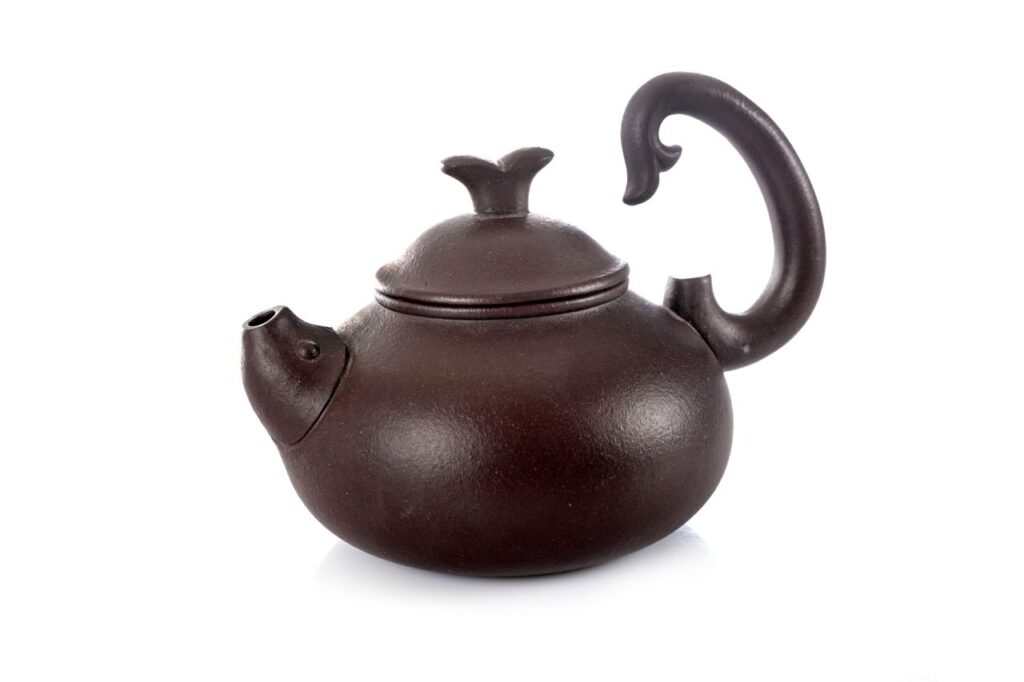
4. How To Clean A Cast Iron Tea Kettle
Apart from limescale, cast iron tea kettles are prone to rust. So, maintenance is really important here. Cleaning a cast iron tea kettle for limescale is similar to electric kettles. So, you can refer to the steps above for reference.
Coke is needed here, yes the soft drink!
This is because coke is really carbonated and has phosphoric acid. Rust will slowly dissolve when it comes into contact with it.
You might also wonder if vinegar can suffice. Sadly, it cannot. Cast iron reacts very differently from vinegar. It may even speed up rusting due to its acetic acid content.
Here are the steps to cleaning your cast iron tea kettle’s exterior:
What You Need
- A can of coke
- Iron mesh brush
- Liquid soap
- Salt and olive oil (optional)
- Small pail or container bigger than your kettle
Directions
- Wash your kettle with liquid detergent and scrub it with your iron mesh brush. This will help remove some rust on the surface.
- Grab your small pail and fill it with your carbonated beverage.
- Take your kettle and let it soak overnight.
- After it soaks, wash it again with liquid soap and water. This should remove most of the accumulated rust. But, if you still see some rusty patches, do this trick:
Salt and Oil Scrub (optional)
- Take a small container and combine two parts of salt with one part of olive oil.
- Massage this pasty mixture over the rusty sections.
- Rinse and wash with water and soap and leave to dry.
- You can take some oil and apply a very thin layer of it to the exterior of the kettle. Applying this will help seal the surface and prevent rust from forming faster.
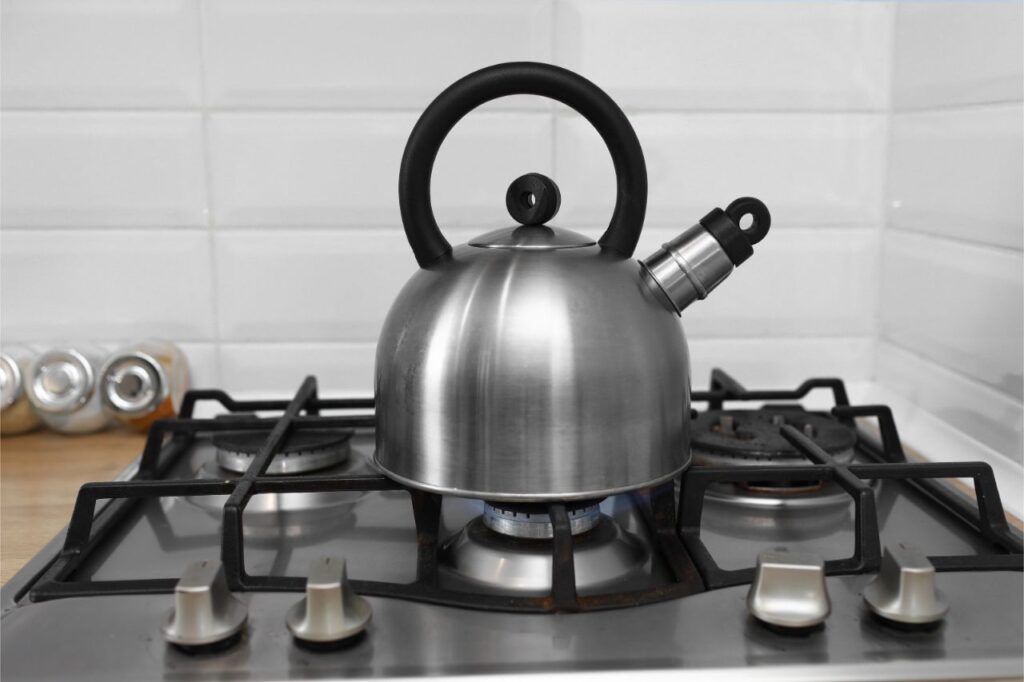
5. How To Clean A Stainless Steel Tea Kettle
For limescale, use the same mixture of water and vinegar as you would for any of the other kinds of kettles mentioned above. If you don’t want to use vinegar, you can replace it with lemon juice. Then, you can scrub the insides with a dish scrubber.
One important thing to note with cleaning stainless steel kettles: Do not use harsh abrasives! Using these will scratch their shiny surface and therefore will leave you with a dull-looking pot. It might also leave scratch marks.
Here’s how you can clean the exterior of your stainless steel kettle:
What You Need
- Baking soda
- Water
- Sponge
- Vinegar
- Cloth
Directions
- Take a clean cloth and lightly soak it with baking soda. Set it aside.
- Mix three parts baking soda to one part water in a container. This should give you a very thick paste.
- Use your sponge or light scrubber, then rub the paste to the exterior. This works really well on tea stains.
- Take your vinegar-soaked cloth and rub it on the surface, wiping off the paste.
- Rinse with water and dry thoroughly.
Note: Drying is another important step here. After you rinse, make sure to dry the kettle with a cloth completely. Or else, your kettle will have water stains.
Why You Should Clean Your Tea Kettle (Besides General Hygiene):
Why else should you bother to routinely clean your teapot? Well, your health and the taste of your tea depend on it. Here’s why:
It May Affect The Taste Of Your Tea
A dirty tea kettle will not provide the same quality of tea as one that has been freshly cleaned. Leaving your kettle uncleaned for an extended period of time causes mineral accumulation. And over time, this will result in a metallic taste in your tea.
Deposit Buildup
CaCO3, often known as limescale, is a mineral found in water that may accumulate over time and tarnish your tea kettle.
Magnesium and other minerals may also accumulate in hard water too.
Your kettle will accumulate a deposit of minerals from water and it differs depending on where you live.
In extreme cases, your tea kettle may acquire a slimy and gunky layer. That’s not great for the tea’s taste or the teapot’s durability.
Bacteria Breeding Ground
Some types of tea kettles have fill lines to help you add just the right amount of water. However, most stovetop tea kettles, don’t.
It’s tempting to leave the extra water in the tea kettle if you’ve added too much. I mean, you can always leave it for later, right? This isn’t the case. Doing this might encourage the growth of bacteria.
The CDC states that certain bacteria may spread through water and make you ill. They also suggest cleaning any appliance that comes into contact with water.
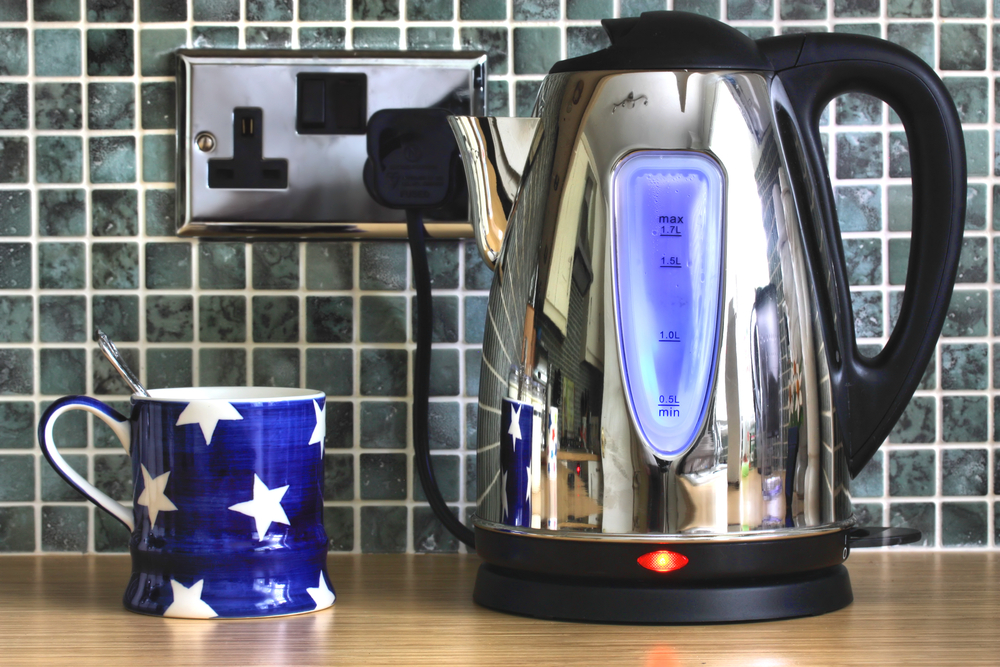
How Often Should You Clean Your Tea Kettle?
Depending on your water, give your kettle a good clean on the first sign of any build-up.
This way, you can frequently prevent buildup from getting out of hand and these aforementioned issues. As for descaling, you can perform this every three months — given that your kettle is properly maintained.
How To Clean A Tea Kettle: The Bottomline
Don’t let limescale ruin your tea kettle and your overall drinking experience.
Although you might only be boiling water in your tea kettle, cleaning is still necessary.
Make sure you know the kind of tea kettle you’re using so you know how to clean it properly and most of all, enjoy your cups of tea!
